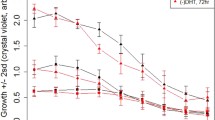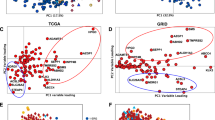Summary
Androgens play an important role in controlling the growth of the normal prostate gland and in the pathogenesis of benign prostate hyperplasia, and prostate cancer. Although testosterone is the main androgen secreted from the testes, dihydrotestosterone (DHT), a more potent androgen converted from testosterone by 5α-reductase isozymes, type I and II, is the major androgen in the prostate cells. The aim of this study is to investigate the cellular and molecular effects of dutasteride, a potent inhibitor of 5α-reductase type I and type II, in androgen-responsive (LNCaP) and androgen-unresponsive (DU145) human prostate cancer(PCa) cell lines. The expression pattern of 190 genes, selected on the basis of their proved or potential role in prostate cancerogenesis related to androgen signalling, were analysed using a low density home-made oligoarray (AndroChip 2). Our results show that dutasteride reduces cell viability and cell proliferation in both cell lines tested. AndroChip 2 gene signature identified in LNCaP a total of 11 genes differentially expressed (FC ≥ ±1.5). Eight of these genes, were overexpressed and three were underexpressed. Overexpressed genes included genes encoding for proteins involved in biosynthesis and metabolism of androgen (HSD17B1;HSD17B3;CYP11B2), androgen receptor and androgen receptor co-regulators (AR;CCND1), and signal transduction(ERBB2; V-CAM; SOS1) whereas, underexpressed genes (KLK3; KLK2; DHCR24) were androgen-regulated genes (ARGs). No differentially expressed genes were scored in DU145. Microarray data were confirmed by quantitative real-time PCR assay (QRT-PCR). These data offer a selective genomic signature for dutasteride treatment in prostate epithelial cells and provide important insights in prostate cancer pathophysiology.



Similar content being viewed by others
References
Jemal A, Siegel R, Ward E, Murray T, Xu J, Thun MJ (2007) Cancer statistics, 2007. CA Cancer J Clin 57:43–66
Isaacs JT (1999) The biology of hormone refractory prostate cancer: Why does it develop? Urol Clin North Am 26:263–273
Zhu YS, Katz MD, Imperato-McGinley J (1998) Natural potent androgens: lessons from human genetic models. Baillieres Clin Endocrinol Metab 12:83–113
Partin A, Rodriguez R (2002) The molecular biology, endocrinology, and physiology of the prostate and seminal vesicles. In: Walsh PC (ed) Campbell’s urology, 8th edn. Saunders, Philadelphia, pp 1237–1296
Grossmann ME, Huang H, Tindall DJ (2001) Androgen receptor signaling in androgen-refractory prostate cancer. J Natl Cancer Inst 93:1687–1697
Russell DW, Wilson JD (1994) Steroid 5 alpha-reductase: two genes/ two enzymes. Annu Rev Biochem 63:25–61
Stoner E (1996) 5α-Reductase inhibitors/finasteride. Prostate 6:82–87
Span PN, Voller MC, Smals AG, Sweep FG, Schalken JA, Feneley MR, Kirby RS (1999) Selectivity of finasteride as an in vivo inhibitor of 5 alpha-reductase isozyme enzymatic activity in the human prostate. J Urol 161:332–337
Bramson HN, Hermann D, Batchelor KW, Lee FW, James MK, Frye SV (1997) Unique preclinical characteristics of GG745, a potent dual inhibitor of 5AR. J Pharmacol Exp Ther 282:1496–1502
Andriole G, Bostwick D, Brawley O, Gomella L, Marberger M, Tindall D, Breed S, Somerville M, Rittmaster R (2004) Chemoprevention of prostate cancer in men at high-risk: rationale and design of the Reduction by Dutasteride of Prostate Cancer Events (REDUCE) trial. J Urol 172:1314–1317
de Longueville F, Atienzar FA, Marcq L, Dufrane S, Evrard S, Wouters L, Leroux F, Bertholet V, Gerin B, Whomsley R, Arnould T, Remacle J, Canning M (2003) Use of a low-density microarray for studying gene expression patterns induced by hepatotoxicants on primary cultures of rat hepatocytes. Toxicol Sci 75:378–92
Fang Y, Brass A, Hoyle DC, Hayes A, Bashein A, Oliver SG, Waddingtong D, Rattray M (2003) A model-based analysis of microarray experimental error and normalisation. Nucleic Acids Res 31:e96
Scharpf RB, Iabocuzio-Donahue CA, Sneddon JB, Parmigiani G (2007) When one should substract background fluorescence in two color microarrays? Biostatistics (in press)
Rajeevan MS, Ranamukhaarachchi DG, Vernon SD, Unger ER (2001) Use of real-time quantitative PCR to validate the results of cDNA array and differential display PCR technologies. Methods 25:443–51
Velasco AM, Gillis KA, Li Y, Brown EL, Sadler TM, Achilleos M, Greenberger LM, Frost P, Bai W, Zhang Y (2004) Identification and validation of novel androgen-regulated genes in prostate cancer. Endocrinology 145:3913–3924
Negri-Cesi P, Poletti A, Colciago A, Magni P, Martini P, Motta M (1998) Presence of 5-alpha-reductase isozymes and aromatase in human prostate cancer cells and in benign prostate hyperplastic tissue. Prostate 34:283–291
Smith CM, Ballard SA, Worman N, Buettner R, Masters JR (1996) 5 Alpha-reductase expression by prostate cancer cell lines and benign prostatic hyperplasia in vitro. J Clin Endocrinol Metab 81:1361
Bartsch G, Rittmaster RS, Klocker H (2002) Dihydrotestosterone and the concept of 5 alpha-reductase inhibition in human benign prostatic hyperplasia. World J Urol 19:413–425
Lazier CB, Thomas LN, Douglas RC, Vessey JP, Rittmaster RS (2004) Dutasteride, the dual 5alpha-reductase inhibitor, inhibits androgen action and promotes cell death in the LNCaP prostate cancer cell line. Prostate 58:130–44
Schmidt LJ, Murillo H, Tindall DJ (2004) Gene expression in prostate cancer cells treated with the dual 5 alpha-reductase inhibitor dutasteride. J Androl 25:944–953
Culig Z, Klocker H, Bartsch G, Steiner H, Hobisch A (2003) Androgen receptors in prostate cancer. J Urol 170:1363–9
Schmidt LJ, Ballman KV, Tindall DJ (2007) Inhibition of fatty acid synthase activity in prostate cancer cells by dutasteride. Prostate 67:1111–1120
Kothapalli R, Yoder SJ, Mane S, Loughran TP (2002) Microarray results: how accurate are they? BMC Bioinformatics 3:22–32
Wen Y, Hu MC, Makino K, Spohn B, Bartholomeusz G, Yan DH, Hung MC (2000) HER-2/neu promotes androgen-independent survival and growth of prostate cancer cells through the Akt pathway. Cancer Res 60:6841–6845
Slamon DJ, Godolphin W, Jones LA, Holt JA, Wong SG, Keith DE, Levin WJ, Stuart SG, Udove J, Ullrich A et al (1998) Studies of the HER-2/neu proto-oncogene in human breast and ovarian cancer. Science 244:707–712
Pietras RJ, Arboleda J, Reese DM, Wongvipat N, Pegram MD, Ramos L, Gorman CM, Parker MG, Sliwkowski MX, Slamon DJ (1995) HER-2 tyrosine kinase pathway targets estrogen receptor and promotes hormone-independent growth in human breast cancer cells. Oncogene 10:2435–2446
Craft N, Shostak Y, Carey M, Sawyers CL (1999) A mechanism for hormone-independent prostate cancer through modulation of androgen receptor signaling by the HER-2/neu tyrosine kinase. Nat Med 5:280–285
Xu Y, Dalrymple SL, Becker RE, Denmeade SR, Isaacs JT (2006) Pharmacologic basis for the enhanced efficacy of dutasteride against prostatic cancers. Clin Cancer Res 12:4072–4079
Mitchell S, Abel P, Ware M, Stamp G, Lalani E (2000) Phenotypic and genotypic characterization of commonly used human prostatic cell lines. BJU Int 85:932–944
Acknowledgements
We thank GlaxoSmithKline for providing us the dutasteride drug and Dr. Roger Rittmaster for the useful comments. This work was in part supported by funds from AIRC (Associazione Italiana per la Ricerca sul Cancro) Regional Grant to G.N.
Author information
Authors and Affiliations
Corresponding author
Additional information
Supplementary Information is linked to web site http://www.geneticaumana.net/ricerca_news_scheda.php?id=53
Rights and permissions
About this article
Cite this article
Biancolella, M., Valentini, A., Minella, D. et al. Effects of dutasteride on the expression of genes related to androgen metabolism and related pathway in human prostate cancer cell lines. Invest New Drugs 25, 491–497 (2007). https://doi.org/10.1007/s10637-007-9070-7
Received:
Accepted:
Published:
Issue Date:
DOI: https://doi.org/10.1007/s10637-007-9070-7




